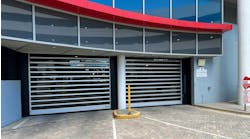Why Buildings That Reduce Carbon Are the Smart Choice for Owners
It can hardly be overstated how important a role buildings play in reducing energy loads and carbon emissions. Not only do buildings account for 40% of all greenhouse gas emissions, but also, nearly two-thirds of the buildings that exist today will still be in use in 2050, according to Gensler’s recent Climate Action Through Design report.
This means the path to resiliency and improving environmental impacts must address adaptive reuse strategies and extend the life of existing structures by renovating them and repurposing spaces and materials to decrease their carbon footprints, the authors of the Gensler report noted.
Here’s what building owners and facility managers need to know about the relationship between carbon and their existing facilities, and the factors they need to keep in mind in the years ahead.
Why Carbon?
“Sustainability in the built environment has historically been focused on the footprint of operations, which is critically important,” said Thomas Knittel, AIA, NCARB, LEED AP, design principal at global architecture firm HDR. “However, projections show that we cannot achieve global greenhouse gas reductions without also addressing embodied carbon, the energy we spend—or the carbon we emit—to make things in the first place. This means new buildings and the ones we revitalize and sustain are important players in this effort.”
But why is carbon such an essential part of the equation? In part, because carbon that’s emitted by building operations “does direct harm to our communities as a result of pollution, which impacts air and water quality, as well as climate change, which increases the severity of storms and extreme weather events,” said Duncan Griffin, AIA, LEED AP BD&C, LEAN, sustainable healthcare leader and managing principal for HDR's Seattle office. Griffin noted that in most cases, the strategies employed to reduce one’s carbon footprint also have a net economic benefit by reducing energy costs, and in some cases, water costs.
More than ever, the bottom line is driving the decision to focus on the long-term effects of carbon on buildings and ensuring their resiliency and value. JoAnna Abrams, CEO of MindClick, a leader in supply chain sustainability performance measurement solutions, noted that insurance companies and investors alike are demanding that the problems associated with the decarbonization of the economy be addressed.
“The data is just too strong and overwhelming anymore—and it’s really not a political argument; it is reality,” she said. “What that means is, if you want your asset to maintain and enhance its value, you as an asset owner are going to need to be demonstrating to the financial community the actions that you’re taking to help protect that asset over a long life.”
[Related: New Building in Spokane to Become Largest Net Zero Energy and Carbon Building in North America]
Challenges and Solutions for Carbon Reduction
There’s no getting around the fact that costs represent a significant barrier to reducing carbon within existing facilities. As Griffin explained, existing infrastructure elements which are in the middle of their life cycle, like a 10-year-old boiler, represent sunk costs that building owners are reluctant to walk away from or may still be paying for.
“Old, leaky building facades can be expensive to replace with better performing options,” he added. “However, there are cases where making these changes may pay for themselves.”
Further, many existing facilities like hospitals need to maintain operations and can’t undergo a full-scale renovation that requires moving people out of the building, according to Lewis Morgante, PE, CEM, LEED AP BD+C, WELL AP, senior sustainability analyst for HDR.
“Making impactful upgrades, like completely replacing core building systems, are more complicated,” he said. “Unfortunately, working in phases almost always adds upfront cost to a renovation, which can be prohibitive even if the carbon reduction and energy cost benefits over time are significant.”
Complicating matters is the fact that the interiors tend to be refreshed multiple times during a building’s life cycle, and the embodied carbon associated with the products and furnishings used has a big impact on its carbon footprint.
“From that standpoint, that’s where, frankly, designers have a big role to play in this [by] carefully selecting products that have a better embodied carbon story,” Abrams said. That involves making material choices that consider packaging, manufacturing practices, disposal of the products, and how the product can reduce operational carbon by operating more efficiently and requiring less energy use, she added.
Fortunately, companies like MindClick have created tools that gather environmental health data of building materials and products and turn them into easy-to-understand, easy-to-compare product intelligence that designers and facility managers can use to answer key questions and improve performance on the interiors side of the equation.
“Broadly speaking, updating the central energy plant is a big part of a more sustainable building,” Griffen said. This means moving from combustion and evaporation-based systems to pumping energy as the driver for thermal comfort, which moves buildings away from fossil fuels and excess water use toward utility electrical resources.
“When we provide renewable energy resources to get to net zero energy, even if the utility is fossil fuel based, we are largely able to offset those carbon emissions,” he pointed out.
Morgante said opportunities exist to both reduce an existing building’s carbon footprint and improve the indoor environment quality for the people who occupy the building every day. If a high-rise office building has an outdated and inadequate ventilation system, for example, people are not getting enough fresh air, which can lead to acute health effects and a loss of productivity.
“Upgrading to a modern system not only lowers energy consumption but will also enable occupants to think more clearly while they work,” he noted.
Final Considerations
“As the world moves closer and closer to causing irreversible damage to the environment, it is imperative for building professionals to consider every option available to reduce a building’s carbon footprint, even if that involves having to research or seek advice on a solution they are unfamiliar with,” Morgante urged.
Over the coming years, he said the way buildings produce and consume energy, and the way energy flows between buildings and the grid will change dramatically. Technical guidance and financial assistance are being made available through governments and local organizations, and it is important for professionals to take full advantage of these mechanisms to allow them to move as quickly as possible, he added.
“We also have great opportunities to rethink how buildings respond in conditions when the utility grid fails,” Griffin noted. Given the ongoing innovation in storage technology, he said net-zero energy buildings with sufficient battery backup can recharge themselves daily while powering buildings that otherwise use grid energy, without the terrible pollution associated with diesel generators.
“This would truly be a gift to the health of the future,” he concluded.
Read next: Take Action Now to Reduce Building Carbon Emissions


